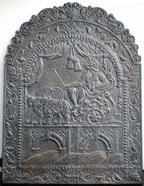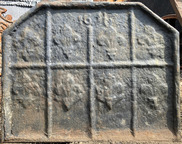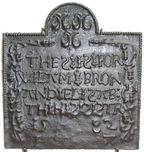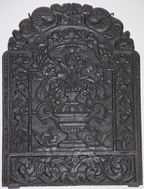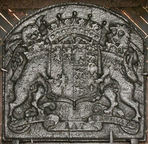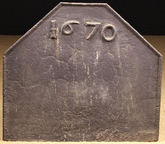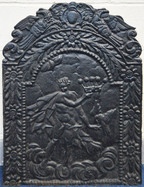-
439
Description: Fragment; left part only; this fireback comprises at least four separate elements: the rectangular central panel has an anchor with coiled rope between two fleurs de lys, below which are two roses; the rectangular side panels each comprise a vertical stem with six ‘grape bunches’ surmounted by a circular grape cluster; above, a semicircular arch contains the initials between two roses as in the central panel, with the date above; where the arch meets the central panel there is an arc across each corner. The side and top panels are edged with simulated twisted rope; to the left and botoom, a plain extension has been added before casting.
Notes: One of an unusual series formed from separate panels. The left panel is likely to have been repeated in the missing section. The extensions to the side and bottom will be unique to this casting which, because of the sharpness of the relief detail, is probably an early example. Because of its date and the use of the anchor motif, this much-copied plate is often referred to as the Armada fireback. No other connection with the sea battle is known. Other firebacks have been cast using some of the separate elements described.
Inscription: 1588 / IFC
- Decoration tags:
- rectangular with round arch (shape)
- none (edging)
- carved pattern panels
- heraldic
- text
- plants
- objects
Manufactured: in 1588 in the Weald area of England.
Current location: Anne of Cleves House, Southover High Street, Lewes, East Sussex, England.
Museum number: 1944.24.060 (part of the Sussex Archaeological Society museum group)
- Attached to series:
- Armada series
- Fleur-de-lys firebacks
-
886
Description: Arched rectangular central panel with ‘nutshell’ edging on a broad fillet; head-dressed figure, holding a sceptre in her right hand, sitting in a chariot drawn to the left by two armadillos; the whole upon a two-arched bridge with masonry, decorated keystones and spandrels, and waves beneath; above, swagged drapery with two tassels hanging from the centre; arched rectangular shaped border with fillet edging, with a symmetrical scrolled wire design; the monogram, SHR, bottom centre; above is a symmetrical design of scrolled floral tendrils.
Notes: The design is derived from a personification of America, one of a set of playing cards entitled 'Jeu de la Géographie', designed by Stefano della Bella (1677). Copies of this fireback were advertised in Bratt Colbran Ltd.'s (London) catalogue in the early-20th century.
Copies of this fireback are known.
Inscription: SHR
- Decoration tags:
- 'Dutch' (shape)
- fillet (edging)
- whole carved pattern
- pictorial
- architectural
- text
- animals
- humans
- objects
Manufactured: in the late-17th to early-18th century in England.
Current location: not known.
- Attached to series:
- SHR series
- British 'Dutch' style firebacks
-
1265
Description: Canted rectangular shape; ?fillet edging; eight fleurs-de-lys (4 and 4) equally spaced and divided by vertical and horizontal fillets, the middle vertical over-stamped at the top with the numerals.
Notes: Only poor quality castings have been noted of this design, with different dates.
Inscription: 16[?]1
- Decoration tags:
- rectangular with canted top corners (shape)
- fillet (edging)
- whole carved pattern
- individual numbers
- heraldic
- text
Manufactured: in the early-17th century possibly in the Weald area of England.
Current location: Ripley Forge and Fireplaces, North Street, Robertsbridge, Salehurst, East Sussex, England.
- Attached to series:
- Miscellaneous stamp firebacks
-
667
Description: Armorial within complex ovolo moulded edging (top and sides); quartered shield, helm, crest and mantling; plain panel below.
Notes: The arms can be identified from the first four quarters on the memorial to Raffe Maynard, d.1613, in St Albans Cathedral; quarterly, 1, Maynard: argent, a chevron azure between three sinister hands couped at the wrist gules; 2, Filleigh: gules, a fess vairy between six crosses formy or; 3, Harris/Hawes/Hewish: gules fretty argent a canton of the second; 4, Lyons: argent a chevron sable between three lions dormant coward gules; the crest, a stag statant, is of Maynard. The Maynards, originally from Devon, were a large family in Rotherfield, and Richard Maynard (d.1619) had an interest in Old Mill, Mayfield, as well as in Birchden forge, and probably Hamsell furnace. An example without the extension panel at the bottom has been noted. A larger fireback with the same arms, and probably by the same pattern maker, can also be seen (no. 144).
Copies of this fireback are known.
Arms: Maynard
- Decoration tags:
- rectangular with round arch (shape)
- ovolo (edging)
- whole carved pattern
- armorial
Manufactured: in the late-16th century in the Weald area of England.
Current location: Hole Park, Rolvenden, Kent, England.
- Attached to series:
- Personal armorial firebacks
- Ornate border series
- Maynard arms firebacks
-
726
Description: Arched rectangular central panel with bead-on-fillet edging; pictorisl scene of a central cross-shaped pillar entwined with a snake; two pavilions to the left with human figures lying before them; two standing figures to the right, one holding a staff; above, clouds with snakes descending from the sky; arched rectangular border with fillet edging; on each side, descending festoons of fruit entwined with ribbon; at the bottom, a central cartouche between palm fronds; on top, foliate swirls.
Notes: The scene is an illustration of the plague of serpents visited upon the children of Israel by God (Numbers 21: 6).
Copies of this fireback are known.
Manufactured: in the mid-17th century possibly in the Siegerland area of Germany.
Current location: Victoria & Albert Museum, Cromwell Road, Kensington & Chelsea, Greater London, England.
Museum number: 291-1893 (part of the Victoria & Albert Museum museum group)
Citation: Anon., 2 Dec 1905, 'Old Kent and Sussex Fire-backs', Country Life, pp. 767-768.
- Attached to series:
- 'Dutch' Miscellaneous Firebacks
- Old Testament & Apocrypha firebacks
-
744
Description: Arched rectangular shape; twisted rope edging (top and sides only); three water bougets (leather water containers) at top; knotted cord and tassel decoration on each side; centred inscription on six lines with ‘S’ reversed, bar across top of ‘A’ and letters individually placed and separated by small, opposed fleurs-de-lys.
Notes: The approximately mirrored cord decoration appears to have been affixed to shaped boards. The Wealden origin of this fireback suggests possible connections with the Roos, or de Ros, family, who owned property in Easebourne, or the Meeres family of Glynleigh, near Hailsham, the arms of both families incorporating water bougets. A connection, previously proposed by the Victoria and Albert Museum, with the Ross family of Helmsley, Yorkshire, is improbable. One of a small series of distinctive firebacks cast in 1582, most with inscriptions dedicated to pairs of individuals; the initials IA may be of the founder as they appear in the same arrangement on other firebacks. Part of the bequest to the Victoria and Albert Museum by Lieut. Colonel G. B. Croft-Lyons in 1926.
Inscription: THES:IS:FOR / WILAM:BRON / AND:ELISAB: / TH:HIS:SISTR / 15 82 / I A
- Decoration tags:
- rectangular with round arch (shape)
- rope (edging)
- simple stamps
- carved stamps
- individual letters
- individual numbers
- heraldic
- text
- objects
Manufactured: in 1582 possibly at Pounsley Furnace, Framfield in the Weald area of England.
Current location: Victoria & Albert Museum, Cromwell Road, Kensington & Chelsea, Greater London, England.
Museum number: M.977-1926 (part of the Victoria & Albert Museum museum group)
- Attached to series:
- Pounsley series
- 1582 IA series
-
755
Description: Arched rectangular central panel with bead-and-pellet edging; on a ground between two plants, a fluted flower vase with two, scrolled handles, tulips and other flowers issuing from the narrow neck; arched rectangular border with fillet edging; mirrored descending flower swags; along a rectangular bottom panel with fillet edging a symmetrical arrangement of swirled foliage; narrow, curved shouldered side panels with beads in oval depressions; on top, two mirrored sea serpents.
Notes: The presence of tulips suggest a Dutch origin for the pattern of this fireback, although the presence of several examples in England suggest that it was produced here rather than on the Continent; this is the smaller of two versions of this fireback.
Copies of this fireback are known.
- Decoration tags:
- 'Dutch' (shape)
- fillet (edging)
- whole carved pattern
- extension panels
- pictorial
- plants
- objects
Manufactured: in the late-17th century in England.
Current location: Victoria & Albert Museum, Cromwell Road, Kensington & Chelsea, Greater London, England.
Museum number: 41.1896 (part of the Victoria & Albert Museum museum group)
- Attached to series:
- British 'Dutch' style firebacks
- Flower Vase 'Dutch' types
-
873
Description: Arched shape; fillet edging; shield, supporters, earl's coronet and motto.
Notes: The arms are those of William Herbert (1626-96), created 1st Earl of Powis in 1674, impaled with those of his wife, Lady Elizabeth Somerset, whom he had married in 1654. He was created Marquess in 1687, so the fireback dates from between 1674 and 1687. The blazon: Party per pale azure and gules three lions rampant argent armed and langued or (Herbert), quarterly 1st and 4th England 2nd and 3rd France Modern (Somerset); Supporters: Dexter: A Panther rampant guardant Argent spotted of various colours fire issuing out of the mouth and ears ducally gorged Azure; Sinister: A Lion rampant Argent ducally gorged Gules; Motto: Ung je serviray (One I will serve).
Inscription: Ung iay serviray
Arms: William Herbert, 1st Earl of Powis
- Decoration tags:
- rounded arched (shape)
- fillet (edging)
- whole carved pattern
- armorial
- text
Manufactured: in the late-17th century .
Current location: Powis Castle, Welshpool, Powys, Wales.
Museum number: 1180869 (part of the National Trust museum group)
Citation: Anon., 1907, 'Armorial iron fire back', Montgomeryshire Collections, 34, p. 212.
- Attached to series:
- Personal armorial firebacks
- Welsh armorial firebacks
-
1020
Description: Canted rectangular shape; twisted rope edging (top and sides); top centre, date formed of individual numerals.
Notes: The '1' has a central button, typical of the period, or of a little earlier. Formerly at Padley Hall, Derbyshire. Wilkinson's, Doncaster, auction 24 Apr 2016 lot 317.
Inscription: 1670
- Decoration tags:
- rectangular with canted top corners (shape)
- rope (edging)
- individual numbers
- text
Manufactured: in 1670 in England.
Current location:, not known.
- Attached to series:
- Date only firebacks
-
1092
Description: Arched rectangular central panel with bead edging; caped naked male figure standing on clouds, head turned over his right shoulder and holding a coronet of five raised baubles aloft in his right hand, on his left hand a bird perched, its wings displayed; above left a cloud; arched rectangular fillet border containing symmetrical, regularly-spaced 'daisy' flowers and festoons of leaves descending there from; on top of the arch, a central cartouche with a mirrored eagle and scrolls on each side.
Notes: The bottom panel of the border is missing, perhaps through breakage, the bottom flower on each side being incomplete and the fillet edging discontinued. The figure, which has yet to be identified, is probably iconic or mythological. The form of the arch suggests an English origin.
- Decoration tags:
- 'Dutch' (shape)
- fillet (edging)
- whole carved pattern
- allegorical
Manufactured: in the late-17th to early-18th century in England.
Current location: not known.
- Attached to series:
- British 'Dutch' style firebacks

